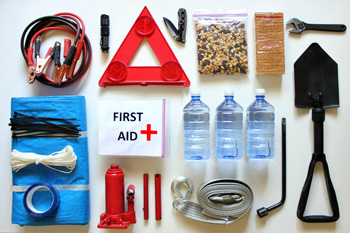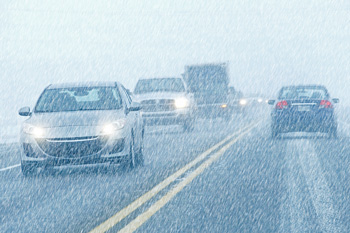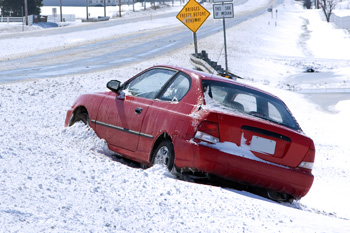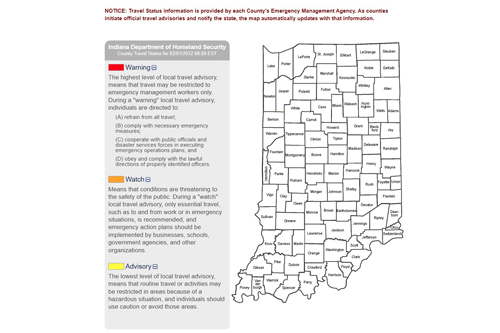Winter Travel
- Get Prepared
- Nature Safety
- Current: Winter Travel
Winter Weather Vehicle Safety Kit
Winter Weather Vehicle Safety Kit
According to the Federal Emergency Management Agency (FEMA), most winter storm-related deaths are caused by vehicle accidents due to ice and snow. Indiana does not experience large winter storms every year, but it only takes a little ice or snow to make driving conditions hazardous. Getting your vehicle prepared before winter weather conditions occur will help make winter traveling safer and less stressful.
Winter Travel Safety Tips
Quick Tips
- Get your vehicle prepared for winter weather by having a mechanic inspect it.
- Keep an emergency kit in your vehicle.
- Drive below the posted speed limit and leave plenty of space between other vehicles. Use your vehicle's hazard lights if driving significantly below the speed limit.
- If stranded, do not leave your vehicle. It protects you from harsh weather conditions. Only leave the vehicle if help is visible within about 100 yards.

Mechanic's Checklist
It is important that your vehicle receives proper maintenance before winter weather arrives. Get your vehicle prepared for winter weather by having a mechanic inspect:
- Antifreeze levels
- Battery
- Belts and hoses
- Brakes
- Defroster
- Headlights, taillights and hazard lights
- Heater
- Oil
- Tires
- Windshield wipers

Vehicle Emergency Kit
Always keep an emergency kit in your vehicle that includes the following items:
- Bag of sand or cat litter (for better tire traction)
- Blankets or a sleeping bag
- Cash
- First aid kit
- Flashlight and extra batteries
- Ice scraper and snow brush
- Jumper cables
- Maps
- Non-perishable, high-protein food
- Portable phone charger
- Road flares
- Shovel
- Spare clothes, mittens, scarves and hats
- Water
- Weather radio

Winter Driving
Snowy and icy roadways during winter weather is a challenge even for the most experienced drivers. Before leaving home, check local news weather reports and the Indiana county travel status map for current travel conditions. As you drive on roadways, make sure you:
- Drive below the posted speed limit and leave plenty of space between other vehicles. If driving significantly below the speed limit, turn on the vehicle's hazard lights.
- Stay attentive and reduce speeds during times of limited visibility.
- Do not tailgate or try to pass snowplows.
- Allow for more braking time on slick and snowy roads.
- Take it slow when approaching intersections, off-ramps and bridges in case of black ice.
- Share your planned destination, route and expected arrival time with someone.
- Keep windows, mirrors, headlights, taillights and brake lights clear of snow and ice.

If Stranded
Getting stranded is a possibility when deciding to travel during winter weather conditions. Besides using a phone to call for help, such as Hoosier Helpers if you are stuck along an interstate highway, follow these tips while you wait for rescue.
- Do not leave your vehicle. It protects you from harsh weather conditions, and you could become disoriented in the wind and snow. Only leave the vehicle if help is visible within about 100 yards (the length of a football field).
- Run the vehicle for about five minutes every half hour for heat. Keep in mind that your vehicle only uses about one gallon of gasoline per hour while idling.
- While running the vehicle for heat, open a window a little to prevent carbon monoxide buildup. Likewise, make sure there is no snow blocking the exhaust pipe.
- Tie a brightly colored cloth to your radio antenna or door to help rescuers see you.
- When it is not snowing, raise the hood of your vehicle to show you need help.
- Turn on the dome light at night while the vehicle is running. It may help rescuers find your vehicle in the dark.
Resources
Websites
- INDOT Trafficwise Map
Indiana Department of Transportation - Winter Driving Safety Tips
Indiana Department of Transportation - Winter Driving Tips
National Highway Traffic Safety Administration - Winter Storms
Indiana Department of Homeland Security - Winter Weather
Ready.gov
Travel Advisories
The Indiana Department of Homeland Security State Emergency Operations Center (SEOC) hosts the statewide county travel status map. Counties decide whether to issue travel advisories, watches or warnings, and the SEOC produces advanced weather summaries and assessments from its Watch Desk to inform county emergency management agency directors, who advise their county commissioners on making these local travel status decisions. When a county emergency management agency reports its county's updated travel status to the state, the change is reflected on the map.
Many state agencies, private sector partners and non-governmental organizations rely on the map to make safe decisions, especially during winter weather conditions. For example, the Indiana National Guard uses the map during times of flooding or heavy snow to help plan its routes through the state.

